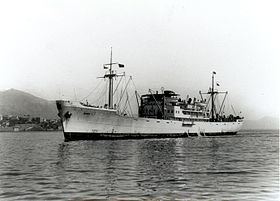Name Ramb I Commissioned 1940 Length 122 m | Launched Banana boat, 1937 Builder Gio. Ansaldo & C. | |
 | ||
Reclassified Auxiliary cruiser, 1940 Fate Sunk by HMNZS Leander, 27 February 1941 | ||
The Italian ship Ramb I was a pre-war "banana boat" that was converted to be an auxiliary cruiser during World War II. The Ramb I operated in the area around the Horn of Africa. It was sunk in the Indian Ocean before it could take a single prize.
Contents
Details
The Ramb I was built at Genoa by Ansaldo in 1937. It had a displacement of 3,667 tons, was oil powered, and was capable of 18½ knots. The Ramb I was the first of four ships of her design. The others were the Ramb II, the Ramb III, and the Ramb IV. These ships were built for the Royal Banana Monopoly Business (Regia Azienda Monopolio Banane) and originally intended to be "banana boats", transporting refrigerated bananas to Europe from Somaliland and Eritrea in Italian East Africa.
Operational history
The design of Ramb I enabled it to be refitted as an "auxiliary cruiser" for commerce raiding and, following Italy's declaration of war on 10 June 1940, she joined the Italian Royal Navy (Regia Marina) as part of the Italian Navy's Red Sea Flotilla. The conversion of the "banana boat" to an armed auxiliary cruiser was done at the Eritrean port of Massawa, where she was armed with two 4.7 inch (120 mm) guns and eight 13.2 mm anti-aircraft guns.
While based at Massawa, Ramb I had an unsuccessful foray into the Red Sea.
By February 1941, the East African Campaign began to go badly for the Italians. Massawa, Ramb I's home port, became threatened by advancing British and Commonwealth forces. On 20 February 1941, along with the Italian colonial ship Eritrea and the Auxiliary Cruiser Ramb II, Ramb I slipped through the British blockade off Perim and sailed into the Indian Ocean. The commander of the Ramb I was intending to raid shipping off the Dutch East Indies.
Destruction in the Indian Ocean
Acting on reports of commerce raiders in the area, the Royal New Zealand Navy light cruiser HMNZS Leander was sent to patrol the area of the Indian Ocean to the south and slightly west of India. On 27 February, Leander intercepted Ramb I off the Maldive Islands and challenged her. Ramb I attempted to bluff Leander with misleading signals but, although Ramb I was not flying Italian colours, Leander ordered her to stop.
Ramb I simultaneously raised the Italian flag and opened fire from 3,000 yards (3,000 m), splinters from her first salvo hitting the Leander. Leander replied with five salvoes within the next minute, leaving Ramb I seriously damaged and on fire. She struck her colours and Leander ceased firing.
Ramb I had been badly damaged and, as Leander closed, the captain gave the order to abandon ship. An explosion then destroyed Ramb I after the majority of the crew had abandoned her. Leander rescued Ramb I's captain and 112 men, of whom one later died from burns. Leander disembarked the survivors at Addu Atoll; the tanker Pearleaf subsequently transported the survivors to prisoner of war camps in Colombo, Ceylon.
